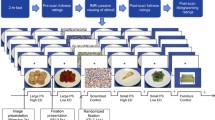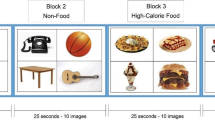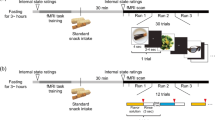Abstract
Food branding is ubiquitous, however, not all children are equally susceptible to its effects. The objectives of this study were to 1) determine whether food brands evoke differential response than non-food brands in brain areas related to motivation and inhibitory control using blood oxygen level dependent (BOLD) functional magnetic resonance imaging (fMRI) and 2) determine the association between brain response and energy intake at test-meals presented with or without brands. Twenty-eight 7–10 year-old children completed four visits as part of a within-subjects design where they consumed three multi-item test-meals presented with familiar food brands, novel food brand, and no brand. On the fourth visit an fMRI was performed where children passively viewed food brands, non-food brands and control images. A whole-brain analysis was conducted to compare BOLD response between conditions. Pearson’s correlations were calculated to determine the association between brain response and meal intake. Relative to non-food brands, food brand images were associated with increased activity in the right lingual gyrus. Relative to control, food and non-food brand images were associated with greater response in bilateral fusiform gyri and decreased response in the cuneus, precuneus, lingual gyrus, and supramarginal gyrus. Less activation in the bilateral fusiform gyrus to both food and non-food brands was associated with greater energy intake of the branded vs unbranded meal. These findings may help explain differences in the susceptibility to the intake-promoting effects of food advertising in children.




Similar content being viewed by others
References
Amaro Jr., E., & Barker, G. J. (2006). Study design in fMRI: Basic principles. Brain and Cognition, 60(3), 220–232.
Badgaiyan, R. D., & Posner, M. I. (1997). Time course of cortical activations in implicit and explicit recall. Journal of Neuroscience, 17(12), 4904–4913.
Bruce, A. S., Lepping, R. J., Bruce, J. M., Cherry, J. B. C., Martin, L. E., Davis, A. M., et al. (2013). Brain responses to food logos in obese and healthy weight children. Journal of Pediatrics, 162(4), 759–764.e2. https://doi.org/10.1016/j.jpeds.2012.10.003.
Bruce, A. S., Bruce, J. M., Black, W. R., Lepping, R. J., Henry, J. M., Cherry, J. B., et al. (2014). Branding and a child's brain: An fMRI study of neural responses to logos. Social Cognitive and Affective Neuroscience, 9(1), 118–122. https://doi.org/10.1093/scan/nss109.
Cavanna, A. E., & Trimble, M. R. (2006). The precuneus: A review of its functional anatomy and behavioural correlates. Brain, 129(3), 564–583.
Connor, S. M. (2006). Food-related advertising on preschool television: Building brand recognition in young viewers. Pediatrics, 118(4), 1478–1485. https://doi.org/10.1542/peds.2005-2837.
Coon, K. A., & Tucker, K. L. (2002). Television and children's consumption patterns. A review of the literature. Minerva Pediatrica, 54(5), 423–436.
Cravener, T. L., Schlechter, H., Loeb, K. L., Radnitz, C., Schwartz, M., Zucker, N., et al. (2015). Feeding strategies derived from behavioral economics and psychology can increase vegetable intake in children as part of a home-based intervention: Results of a pilot study. Journal of the Academy of Nutrition and Dietetics, 115(11), 1798–1807. https://doi.org/10.1016/j.jand.2015.03.024.
de Zubicaray, G. I., Wilson, S. J., McMahon, K. L., & Muthiah, S. (2001). The semantic interference effect in the picture-word paradigm: An event-related fMRI study employing overt responses. Human Brain Mapping, 14(4), 218–227.
Eklund, A., Nichols, T. E., & Knutsson, H. (2016). Cluster failure: why fMRI inferences for spatial extent have inflated false-positive rates. Proceedings of the National Academy of Sciences, 113(28), 7900–7905.
English, L., Lasschuijt, M., & Keller, K. L. (2015). Mechanisms of the portion size effect. What is known and where do we go from here? Appetite, 88, 39–49.
Escalante de Cruz, A., Phillips, S., Visch, M., & Bulan Saunders, D. (2004). The junk food generation: A multi-country survey of the influence of television advertisements on children. Kuala Lumpur: Consumers International Asia Pacific Office.
Esch, F. R., Möll, T., Schmitt, B., Elger, C. E., Neuhaus, C., & Weber, B. (2012). Brands on the brain: Do consumers use declarative information or experienced emotions to evaluate brands? Journal of Consumer Psychology, 22(1), 75–85.
Fearnbach, S. N., Thivel, D., Meyermann, K., & Keller, K. L. (2015). Intake at a single, palatable buffet test meal is associated with total body fat and regional fat distribution in children. Appetite, 92, 233–239. https://doi.org/10.1016/j.appet.2015.05.036.
Fearnbach, S. N., Silvert, L., Keller, K. L., Genin, P. M., Morio, B., Pereira, B., et al. (2016). Reduced neural response to food cues following exercise is accompanied by decreased energy intake in obese adolescents. International Journal of Obesity, 40(1), 77–83. https://doi.org/10.1038/ijo.2015.215.
Fisher, J. O., Liu, Y., Birch, L. L., & Rolls, B. J. (2007). Effects of portion size and energy density on young children’s intake at a meal. The American Journal of Clinical Nutrition, 86(1), 174–179.
Forman, S. D., Cohen, J. D., Fitzgerald, M., Eddy, W. F., Mintun, M. A., & Noll, D. C. (1995). Improved assessment of significant activation in functional magnetic resonance imaging (fMRI): Use of a cluster-size threshold. Magnetic Resonance in Medicine, 33(5), 636–647.
Forman, J., Halford, J. C., Summe, H., MacDougall, M., & Keller, K. L. (2009). Food branding influences ad libitum intake differently in children depending on weight status. Results of a pilot study. Appetite, 53(1), 76–83. https://doi.org/10.1016/j.appet.2009.05.015.
Fox, M. K., Pac, S., Devaney, B., & Jankowski, L. (2004). Feeding infants and toddlers study: What foods are infants and toddlers eating? Journal of the American Dietetic Association, 104, 22–30.
Garoff, R. J., Slotnick, S. D., & Schacter, D. L. (2005). The neural origins of specific and general memory: The role of the fusiform cortex. Neuropsychologia, 43(6), 847–859.
Gauthier, I., Tarr, M. J., Anderson, A. W., Skudlarski, P., & Gore, J. C. (1999). Activation of the middle fusiform'face area'increases with expertise in recognizing novel objects. Nature Neuroscience, 2(6), 568–573.
Gearhardt, A. N., Yokum, S., Stice, E., Harris, J. L., & Brownell, K. D. (2014). Relation of obesity to neural activation in response to food commercials. Social Cognitive and Affective Neuroscience, 9(7), 932–938.
Gilboa, A., Winocur, G., Grady, C. L., Hevenor, S. J., & Moscovitch, M. (2004). Remembering our past: Functional neuroanatomy of recollection of recent and very remote personal events. Cerebral Cortex, 14(11), 1214–1225.
Goebel, R., Esposito, F., & Formisano, E. (2006). Analysis of functional image analysis contest (FIAC) data with brainvoyager QX: From single-subject to cortically aligned group general linear model analysis and self-organizing group independent component analysis. Human Brain Mapping, 27(5), 392–401. https://doi.org/10.1002/hbm.20249.
Grier, S. (2009). African American and Hispanic youth vulnerability to target marketing: Implications for understanding the effects of digital marketing. Paper presented at the BMSG Meeting on Digital Media and Marketing to Children.
Grier, S. A., & Kumanyika, S. K. (2008). The context for choice: Health implications of targeted food and beverage marketing to African Americans. American Journal of Public Health, 98(9), 1616–1629.
Grier, S. A., & Kumanyika, S. (2010). Targeted marketing and public health. Annual Review of Public Health, 31, 349–369.
Hales, C. M., Carroll, M. D., Fryar, C. D., & Ogden, C. L. (2017). Prevalence of obesity among adults and youth: United States, 2015–2016: US Department of Health and Human Services, Centers for Disease Control and Prevention, National Center for Health Statistics.
Halford, J. C. G., Gillespie, J., Brown, V., Pontin, E. E., & Dovey, T. M. (2004). Effect of television advertisements for foods on food consumption in children. Appetite, 42(2), 221–225. https://doi.org/10.1016/j.appet.2003.11.006.
Halford, J. C. G., Boyland, E. J., Hughes, G., Oliveira, L. P., & Dovey, T. M. (2007). Beyond-brand effect of television (TV) food advertisements/commercials on caloric intake and food choice of 5-7-year-old children. Appetite, 49(1), 263–267. https://doi.org/10.1016/j.appet.2006.12.003.
Harris, J. L., Bargh, J. A., & Brownell, K. D. (2009). Priming effects of television food advertising on eating behavior. Health Psychology, 28(4), 404–413. https://doi.org/10.1037/a0014399.
Harris, J. L., Schwartz, M. B., & Brownell, K. D. (2010). Evaluating fast food nutrition and marketing to youth. New Haven: Yale Rudd Center for Food Policy & Obesity.
Harris, J. L., Schwartz, M. B., Brownell, K. D., Sarda, V., Dembek, C., Munsell, C., et al. (2012). Cereal FACTS 2012: limited progress in the nutrition quality and marketing of children’s cereals. New Haven: Rudd Center for Food Policy & Obesity.
Harris, J. L., Schwartz, M. B., Munsell, C. R., Dembek, C., Liu, S., LoDolce, M., & Kidd, B. (2013). Fast food FACTS 2013: Measuring progress in nutrition and marketing to children and teens. New Haven: Yale Rudd Center for Food Policy and Obesity.
Harris, J. L., Schwartz, M. B., LoDolce, M., Munsell, C., Fleming-Milici, F., Elsey, J., et al. (2014). Sugary drink FACTS 2014: Some progress but much room for improvement in marketing to youth. New Haven: Rudd Center for Food Policy and Obesity.
Harris, J. L., Schwartz, M., Shehan, C., Hyary, M., Appel, J., Haraghey, K., & Li, X. (2015). Snack FACTS 2015: Evaluating snack food nutrition and marketing to youth. Rudd Center for Food Policy & Obesity.
Hillis, A. E., Newhart, M., Heidler, J., Barker, P. B., Herskovits, E. H., & Degaonkar, M. (2005). Anatomy of spatial attention: Insights from perfusion imaging and hemispatial neglect in acute stroke. Journal of Neuroscience, 25(12), 3161–3167.
Hochberg, Y., & Benjamini, Y. (1990). More powerful procedures for multiple significance testing. Statistics in Medicine, 9(7), 811–818.
Keller, K. L., Assur, S. A., Torres, M., Lofink, H. E., Thornton, J. C., Faith, M. S., & Kissileff, H. R. (2006). Potential of an analog scaling device for measuring fullness in children: Development and preliminary testing. Appetite, 47(2), 233–243. https://doi.org/10.1016/j.appet.2006.04.004.
Keller, K. L., Kuilema, L. G., Lee, N., Yoon, J., Mascaro, B., Combes, A. L., et al. (2012a). The impact of food branding on children's eating behavior and obesity. Physiology & Behavior, 106(3), 379–386. https://doi.org/10.1016/j.physbeh.2012.03.011.
Keller, K. L., Kuilema, L. G., Lee, N., Yoon, J., Mascaro, B., Combes, A. L., et al. (2012b). The impact of food branding on children's eating behavior and obesity. Physiology & Behavior, 106(3), 379–386. https://doi.org/10.1016/j.physbeh.2012.03.011.
Killgore, W. D., Young, A. D., Femia, L. A., Bogorodzki, P., Rogowska, J., & Yurgelun-Todd, D. A. (2003). Cortical and limbic activation during viewing of high-versus low-calorie foods. Neuroimage, 19(4), 1381–1394.
Labudda, K., Woermann, F. G., Mertens, M., Pohlmann-Eden, B., Markowitsch, H. J., & Brand, M. (2008). Neural correlates of decision making with explicit information about probabilities and incentives in elderly healthy subjects. Experimental Brain Research, 187(4), 641–650.
Lang, P. J. (2005). International affective picture system (IAPS): Affective ratings of pictures and instruction manual. Gainesville: Technical report.
Masterson, T. D., Kirwan, C. B., Davidson, L. E., & LeCheminant, J. D. (2016). Neural reactivity to visual food stimuli is reduced in some areas of the brain during evening hours compared to morning hours: An fMRI study in women. Brain Imaging and Behavior, 10(1), 68–78.
Maynard, O. M., Brooks, J. C., Munafò, M. R., & Leonards, U. (2017). Neural mechanisms underlying visual attention to health warnings on branded and plain cigarette packs. Addiction, 112(4), 662–672.
McClure, A. C., Tanski, S. E., Gilbert-Diamond, D., Adachi-Mejia, A. M., Li, Z., Li, Z., & Sargent, J. D. (2013). Receptivity to television fast-food restaurant marketing and obesity among US youth. American Journal of Preventive Medicine, 45(5), 560–568.
McDermott, L., O'Sullivan, T., Stead, M., & Hastings, G. (2006). International food advertising, pester power and its effects. International Journal of Advertising, 25(4), 513–539.
McGonigle, D. J. (2012). Test-retest reliability in fMRI: Or how I learned to stop worrying and love the variability. Neuroimage, 62(2), 1116–1120. https://doi.org/10.1016/j.neuroimage.2012.01.023.
Muzik, O., Chugani, D. C., Juhász, C., Shen, C., & Chugani, H. T. (2000). Statistical parametric mapping: Assessment of application in children. Neuroimage, 12(5), 538–549.
Nicklas, T. A., Yang, S.-J., Baranowski, T., Zakeri, I., & Berenson, G. (2003). Eating patterns and obesity in children: The Bogalusa heart study. American Journal of Preventive Medicine, 25(1), 9–16.
Okada, T., Tanaka, S., Nakai, T., Nishizawa, S., Inui, T., Sadato, N., et al. (2000). Naming of animals and tools: A functional magnetic resonance imaging study of categorical differences in the human brain areas commonly used for naming visually presented objects. Neuroscience Letters, 296(1), 33–36.
Pelchat, M. L., Johnson, A., Chan, R., Valdez, J., & Ragland, J. D. (2004). Images of desire: Food-craving activation during fMRI. Neuroimage, 23(4), 1486–1493.
Powell, L. M., Schermbeck, R. M., & Chaloupka, F. J. (2013). Nutritional content of food and beverage products in television advertisements seen on Children's programming. Childhood Obesity, 9(6), 524–531. https://doi.org/10.1089/chi.2013.0072.
Price, D. D. (2000). Psychological and neural mechanisms of the affective dimension of pain. Science, 288(5472), 1769–1772.
Robinson, T. N., Borzekowski, D. L., Matheson, D. M., & Kraemer, H. C. (2007). Effects of fast food branding on young children's taste preferences. Archives of Pediatrics & Adolescent Medicine, 161(8), 792–797.
Rothemund, Y., Preuschhof, C., Bohner, G., Bauknecht, H.-C., Klingebiel, R., Flor, H., & Klapp, B. F. (2007). Differential activation of the dorsal striatum by high-calorie visual food stimuli in obese individuals. Neuroimage, 37(2), 410–421.
Sanchez, C. E., Richards, J. E., & Almli, C. R. (2012). Age-specific MRI templates for pediatric neuroimaging. Developmental Neuropsychology, 37(5), 379–399.
Schienle, A., Schäfer, A., Walter, B., Stark, R., & Vaitl, D. (2005). Brain activation of spider phobics towards disorder-relevant, generally disgust-and fear-inducing pictures. Neuroscience Letters, 388(1), 1–6.
Somerville, L. H., & Casey, B. (2010). Developmental neurobiology of cognitive control and motivational systems. Current Opinion in Neurobiology, 20(2), 236–241.
Somerville, L. H., Jones, R. M., & Casey, B. (2010). A time of change: Behavioral and neural correlates of adolescent sensitivity to appetitive and aversive environmental cues. Brain and Cognition, 72(1), 124–133.
Story, M., & French, S. (2004). Food advertising and marketing directed at children and adolescents in the US. International Journal of Behavioral Nutrition and Physical Activity, 1(1), 3. https://doi.org/10.1186/1479-5868-1-3.
Thesen, S., Heid, O., Mueller, E., & Schad, L. R. (2000). Prospective acquisition correction for head motion with image-based tracking for real-time fMRI. Magnetic Resonance in Medicine, 44(3), 457–465.
Valkenburg, P. M., & Buijzen, M. (2002). Appeals in television advertising: A content analysis of commercials aimed at children and teenagers. Communications - the European Journal of Communication Research, 27(3), 349–364.
Woo, C.-W., Krishnan, A., & Wager, T. D. (2014). Cluster-extent based thresholding in fMRI analyses: Pitfalls and recommendations. Neuroimage, 91, 412–419.
Yokum, S., Ng, J., & Stice, E. (2011). Attentional bias to food images associated with elevated weight and future weight gain: An fMRI study. Obesity, 19(9), 1775–1783.
Yokum, S., Gearhardt, A. N., Harris, J. L., Brownell, K. D., & Stice, E. (2014). Individual differences in striatum activity to food commercials predict weight gain in adolescents. Obesity, 22(12), 2544–2551.
Acknowledgments
We would like to thank the parents and children who participated in this project. We would like to acknowledge the support of the USDA/NIFA Childhood Obesity Prevention Training Grant #2011-67001-30117 for study funding and doctoral fellowship program support. We would also like to thank the Social, Life, and Engineering Sciences Imaging Center at Penn State for imaging support.
Author information
Authors and Affiliations
Corresponding author
Ethics declarations
Conflict of interest
The authors declare that they have no conflict of interest.
Ethical approval
All procedures performed in studies involving human participants were in accordance with the ethical standards of the institutional and/or national research committee and with the 1964 Helsinki declaration and its later amendments or comparable ethical standards.
Rights and permissions
About this article
Cite this article
Masterson, T.D., Stein, W.M., Beidler, E. et al. Brain response to food brands correlates with increased intake from branded meals in children: an fMRI study. Brain Imaging and Behavior 13, 1035–1048 (2019). https://doi.org/10.1007/s11682-018-9919-8
Published:
Issue Date:
DOI: https://doi.org/10.1007/s11682-018-9919-8




